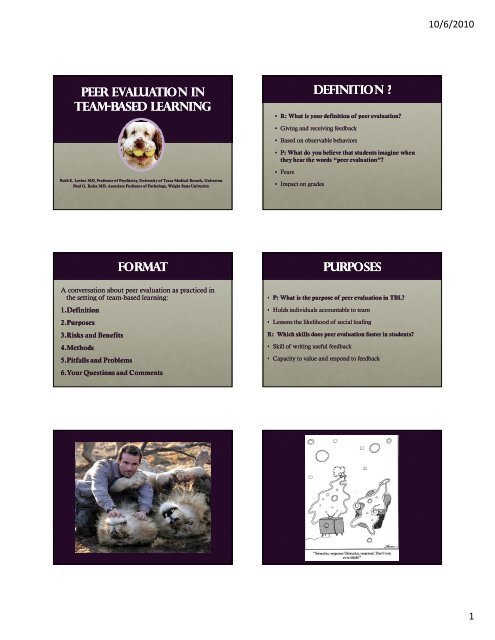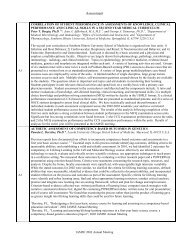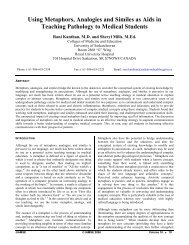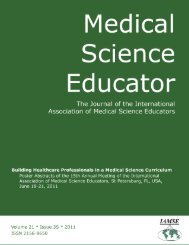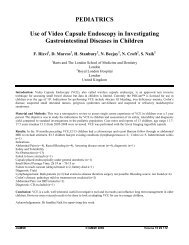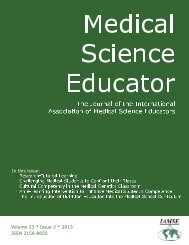Peer Evaluation in Team-Based Learning Based Learning ... - IAMSE
Peer Evaluation in Team-Based Learning Based Learning ... - IAMSE
Peer Evaluation in Team-Based Learning Based Learning ... - IAMSE
Create successful ePaper yourself
Turn your PDF publications into a flip-book with our unique Google optimized e-Paper software.
10/6/2010<br />
<strong>Peer</strong> <strong>Evaluation</strong> <strong>in</strong><br />
<strong>Team</strong>-<strong>Based</strong> Learn<strong>in</strong>g<br />
Def<strong>in</strong>ition <br />
• R: What is your def<strong>in</strong>ition of peer evaluation<br />
• Giv<strong>in</strong>g and receiv<strong>in</strong>g feedback<br />
• <strong>Based</strong> on observable behaviors<br />
Ruth E. Lev<strong>in</strong>e MD, Professor of Psychiatry, University of Texas Medical Ruth E. Branch, Lev<strong>in</strong>eGalveston<br />
MD, Professor of Psychiatry, University of Texas Medical Branch, Galveston<br />
Paul G. Koles MD, Associate Professor of Pathology, Wright State University Paul G. Koles MD, Associate Professor of Pathology, • Impact Wrighton State grades<br />
University<br />
• P: What do you believe that students imag<strong>in</strong>e when<br />
they hear the words “peer evaluation”<br />
• Fears<br />
Format<br />
A conversation about peer evaluation as practiced <strong>in</strong><br />
the sett<strong>in</strong>g of team-based learn<strong>in</strong>g:<br />
1.Def<strong>in</strong>ition<br />
2.Purposes<br />
3.Risks and Benefits<br />
4.Methods<br />
5.Pitfalls and Problems<br />
6.Your Questions and Comments<br />
PURPOSES<br />
• P: What is the purpose of peer evaluation <strong>in</strong> TBL<br />
• Holds <strong>in</strong>dividuals accountable to team<br />
• Lessens the likelihood of social loaf<strong>in</strong>g<br />
R: Which skills does peer evaluation foster <strong>in</strong> students<br />
• Skill of writ<strong>in</strong>g useful feedback<br />
• Capacity to value and respond to feedback<br />
1
10/6/2010<br />
Risks and Benefits<br />
• P: How do you alleviate the discomfort that many students<br />
feel when they are required to do peer evaluation<br />
• Open discussion about fears<br />
• Evidence that fears are unwarranted<br />
• Walk through the process to demystify peer evaluation<br />
• R: How do you reassure students that peer evaluation will be<br />
beneficial<br />
• Empowers students to reward teammates and act like faculty<br />
• Fosters more powerful learn<strong>in</strong>g with<strong>in</strong> team<br />
Methods<br />
• P: Would you expla<strong>in</strong> how Dr. Larry Michaelsen<br />
accomplishes peer evaluation with his students<br />
• Form<br />
• Requires unequal distribution of po<strong>in</strong>ts among teammates<br />
• Comments to support “highest rat<strong>in</strong>gs”<br />
• R: What do you feel are the advantages and disadvantages<br />
of the Michaelsen method<br />
• Advantage: rewards positive and penalizes negative behaviors<br />
Methods (2)<br />
• P: Would you expla<strong>in</strong> how Dr. Dee F<strong>in</strong>k accomplishes peer<br />
evaluation with his students Please discuss advantages and<br />
disadvantages.<br />
• Form<br />
• Advantages<br />
• Allows student the choice to discrim<strong>in</strong>ate or not<br />
• Prevents grade <strong>in</strong>flation<br />
• Qualitative feedback may be added<br />
• Disadvantages<br />
• Students may underestimate impact on grades<br />
• Disadvantage: forced discrim<strong>in</strong>ation may be <strong>in</strong>appropriate<br />
Larry Michaelsen, 2004.<br />
<strong>Team</strong>-<strong>Based</strong> Learn<strong>in</strong>g:<br />
A Transformative Use of<br />
Small Groups <strong>in</strong> College<br />
Teach<strong>in</strong>g. Stylus<br />
Publish<strong>in</strong>g, Sterl<strong>in</strong>g, VA<br />
Dee F<strong>in</strong>k, 2004.<br />
<strong>Team</strong>-<strong>Based</strong> Learn<strong>in</strong>g:<br />
A Transformative Use<br />
of Small Groups <strong>in</strong><br />
College Teach<strong>in</strong>g.<br />
Stylus Publish<strong>in</strong>g,<br />
Sterl<strong>in</strong>g, VA<br />
2
10/6/2010<br />
Paul Koles, Revised<br />
August 2009<br />
Qualitative Component<br />
Two questions added to F<strong>in</strong>k method:<br />
1) “In what ways was your teammate most helpful to<br />
the team<br />
2) “In what ways could your teammate improve to be<br />
more effective<br />
Methods (3)<br />
Pitfalls and Problems<br />
• R: Would you expla<strong>in</strong> how you accomplish peer evaluation<br />
with medical students Please discuss the advantages and<br />
disadvantages of your method.<br />
• Form<br />
• Advantages:<br />
• all teammates receive faculty op<strong>in</strong>ion about quality of comments<br />
• all teammates receive quantitative rat<strong>in</strong>gs and free-text comments<br />
• Disadvantages:<br />
• high grades common (no discrim<strong>in</strong>ation required)<br />
• faculty <strong>in</strong>vest considerable time <strong>in</strong> grad<strong>in</strong>g quality of comments<br />
• P: What are common errors made by faculty who <strong>in</strong>troduce peer<br />
evaluation <strong>in</strong> their courses for the first time<br />
• R: do<strong>in</strong>g peer evaluations too often or too early<br />
• P: poor orientation to purposes and constructive feedback<br />
• R: What mistakes have we made as we implemented peer<br />
evaluation<br />
• P: us<strong>in</strong>g only quantitative rat<strong>in</strong>gs to determ<strong>in</strong>e grades<br />
• R: method that allowed everyone to receive highest score<br />
3
10/6/2010<br />
Questions & Comments<br />
P: What are the most important lessons<br />
we have learned by do<strong>in</strong>g peer evaluation<br />
<strong>in</strong> the sett<strong>in</strong>g of team-based learn<strong>in</strong>g<br />
R: peer evaluation is the most culturally<br />
sensitive component of TBL<br />
P: peer evaluation is learn<strong>in</strong>g lab for<br />
develop<strong>in</strong>g skills needed <strong>in</strong> careers<br />
Please speak to us!<br />
Selected References<br />
• Cestone CM, Lev<strong>in</strong>e RE, Lane DR: <strong>Peer</strong> Assessment and <strong>Evaluation</strong>Cestone <strong>in</strong> <strong>Team</strong>CM, -<strong>Based</strong><br />
Lev<strong>in</strong>e RE, Lane DR: <strong>Peer</strong> Assessment and <strong>Evaluation</strong> <strong>in</strong> <strong>Team</strong><br />
Learn<strong>in</strong>g. New Directions <strong>in</strong> Teach<strong>in</strong>g and Learn<strong>in</strong>g, Jossey-Bass, San Francisco, number<br />
116, w<strong>in</strong>ter 2008.<br />
• Cheng W, Warren M: Mak<strong>in</strong>g A Difference: Us<strong>in</strong>g <strong>Peer</strong>s to Assess Individual Cheng W, Warren Students’ M: Mak<strong>in</strong>g A Difference: Us<strong>in</strong>g <strong>Peer</strong>s to Assess Individual Students’<br />
Contributions to a Group Project. Teach<strong>in</strong>g <strong>in</strong> Higher Education 5(2): Contributions 243-255.<br />
to a Group Project. Teach<strong>in</strong>g <strong>in</strong> Higher Education 5(2): 243<br />
• Heyl<strong>in</strong>gs DJ, Stefani LAJ: <strong>Peer</strong> Assessment Feedback Mark<strong>in</strong>g <strong>in</strong> a Large Heyl<strong>in</strong>gs Medical DJ, Stefani LAJ: <strong>Peer</strong> Assessment Feedback Mark<strong>in</strong>g <strong>in</strong> a Large Medical<br />
Anatomy Class. Journal of Medical Education 31:281-286.<br />
286.<br />
• Lev<strong>in</strong>e RE: <strong>Peer</strong> <strong>Evaluation</strong> <strong>in</strong> <strong>Team</strong>-<strong>Based</strong> Learn<strong>in</strong>g. In <strong>Team</strong>-<strong>Based</strong> Learn<strong>in</strong>g for Health<br />
Professions Education; edited by Michaelsen LK, Parmelee DX, McMahon Professions KK, Education; Lev<strong>in</strong>e RE. edited by Michaelsen LK, Parmelee DX, McMahon KK, Lev<strong>in</strong>e RE.<br />
Stylus Publish<strong>in</strong>g, Sterl<strong>in</strong>g, Virg<strong>in</strong>ia, 2008.<br />
• Lev<strong>in</strong>e RE, Kelly PA, Karokoc T, Haidet P: <strong>Peer</strong> <strong>Evaluation</strong> <strong>in</strong> a Cl<strong>in</strong>ical Lev<strong>in</strong>eClerkship:<br />
RE, Kelly PA, Karokoc T, Haidet P: <strong>Peer</strong> <strong>Evaluation</strong> <strong>in</strong> a Cl<strong>in</strong>ical Clerkship:<br />
Students’ Attitudes, Experience, and Correlations with Traditional Assessments. Students’ Attitudes, Academic Experience, and Correlations with Traditional Assessments. Academic<br />
Psychiatry 31(1):19-24.<br />
• Michaelsen LK, F<strong>in</strong>k LD: Calculat<strong>in</strong>g <strong>Peer</strong> <strong>Evaluation</strong> Scores. In <strong>Team</strong> Michaelsen -<strong>Based</strong> LK, Learn<strong>in</strong>g:<br />
F<strong>in</strong>k LD: Calculat<strong>in</strong>g <strong>Peer</strong> <strong>Evaluation</strong> Scores. In <strong>Team</strong><br />
A Transformative Use of Small Groups <strong>in</strong> College Teach<strong>in</strong>g. Stylus APublish<strong>in</strong>g, Transformative Sterl<strong>in</strong>g, Use of Small Groups <strong>in</strong> College Teach<strong>in</strong>g. Stylus Publish<strong>in</strong>g, Sterl<strong>in</strong>g,<br />
Virg<strong>in</strong>ia, 2004.<br />
• Norc<strong>in</strong>i JJ: <strong>Peer</strong> Assessment of Competence. Journal of Medical Education Norc<strong>in</strong>i 37:539 JJ: <strong>Peer</strong> -543.<br />
Assessment of Competence. Journal of Medical Education 37:539<br />
• VanRosendaal GM, Jennett PA: Resistance to <strong>Peer</strong> <strong>Evaluation</strong>s <strong>in</strong> anVanRosendaal Internal Medic<strong>in</strong>e GM, Jennett PA: Resistance to <strong>Peer</strong> <strong>Evaluation</strong>s <strong>in</strong> an Internal Medic<strong>in</strong>e<br />
Residency. Academic Medic<strong>in</strong>e 67(1): 63.<br />
4


